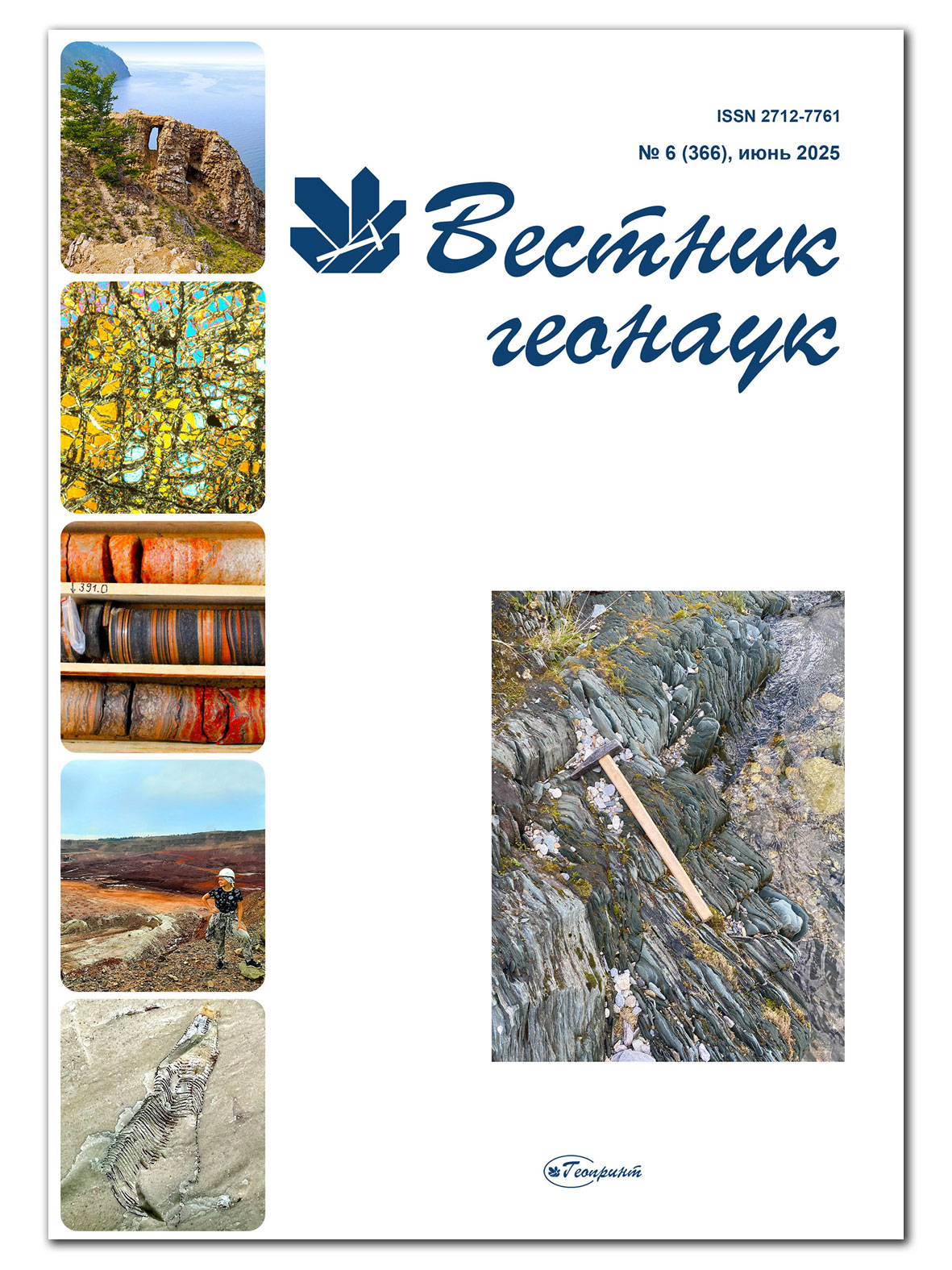|
On the cover: sheared metaterrigenous rocks of the Alkesvozh suite
(Alkesvozh Creek, Subpolar Urals). Photo by N. N. Noskova
|
|
| |
|
|
 Title page Title page
|
1
|
|
 Content Content
|
2
|
| |
|
|
|
|
Scientific articles
|
|
Conditions of gold mineralization formation in mineralized zones of the Yagodnoye ore
occurrence based on chlorite geothermometry (Manitanyrd Ridge, Polar Urals)
T. P. Mayorova, L. I. Efanova
|
3—13
|
Silicon in ferromanganese crusts from the Sea of Japan:
peculiarities of allocation and interrelation with main ore phases
N. V. Astakhova
DOI: 10.19110/geov.2025.6.2
The article considers the distribution features of siliceous mineralization in ferromanganese crusts of the Sea of Japan. The crusts are formed near the top parts of submarine volcanos. Both manganese crusts and ferrosiliceous crusts with manganese admixture were found on some of them, among the dredging material. The main rock-forming elements in the crusts are Mn (0.2—63.1 %), Fe (0.01—42.5 %) and Si (0.4—37.9 %). The Fe/Si value varies from 0.01 to 5.5, Mn/Si — from 0.01 to 177.5. The silicon content varies significantly not only in samples collected at different rises, but also in samples raised at the same station. In addition to ferrosiliceous crusts, formed as a result of quartz cementation of grains of presumably glauconite (celadonite), crusts where the same glauconite is cemented by manganese hydroxides have a high silicon content. The samples with amorphous silica areas along with the manganese matrix, or where the sediment is impregnated with manganese hydroxides, have an increased Si content. The general pattern of ore deposition on underwater volcanoes in the Sea of Japan is as follows: Fe-Si ® Si ® Mn ® Ba. This pattern is distorted in some cases, which is most likely conditioned by the pulsating flow of hydrothermal fluids during subsequent volcanic activity.
Keywords: ferromanganese crusts, silicon, Fe-slides, Sea of Japan
 Download full text Download full text
|
14—23
|
Lithological-paleogeographical zonation of the European North-East of Russia
and correlation of moraines within territorial zones
L. N. Andreicheva
DOI: 10.19110/geov.2025.6.3
For the first time, based on geological, paleoglaciological and paleogeomorphological factors of glaciolithogenesis and their influence on the formation of the composition of moraines, the lithological and paleogeographic zoning of the European North-East of Russia was carried out. 32 littoral regions were identified, which were elementary units of zoning, within which the lithological correlation of moraines was carried out without hindrance in any direction. The map of littoral regions was compiled taking into account the results of a comprehensive lithological study of moraines. The structural (granulometric) characteristics of the Pechora (Dnieper) and Vychegda (Moscow) moraines of the Middle Neopleistocene were obtained, the mineral composition of the fine-sand fraction and the petrography of the coarse-grained material from the moraine horizons were studied. Mineralogical and petrographic features, orientation of detrital material, index rocks in moraines, as well as potassium-argon dating of boulders of crystalline rocks allowed reliable identification of locations of feeding glacial provinces. The compiled map is proposed to be used as a basis for regional and interregional lithological comparisons of moraines.
Keywords: complex lithological analysis, Middle Neopleistocene, moraine, paleogeographic reconstructions, correlation, littoral, territorial zone
 Download full text Download full text
|
24—38
|
A new genus of stromatolites from the Paleoproterozoic of the Karelian craton
A. V. Lyutikov, P. V. Medvedev
DOI: 10.19110/geov.2025.6.4
The article studies a new genus of stromatolites, Severinsaaria unica gen. nov., which was discovered on the Karelian craton of the Fennoscandian Shield. The stromatolites were found in carbonate rocks from the Upper Jatulian section of the Paleoproterozoic period, on the southwestern coast of Lake Segozero, in the Central Karelian stromatolite province. The study used various methods, such as optical and electron microscopy, graphic preparation, and 3D visualization using Blender software. Severinsaaria was compared with other columnar stromatolites from the study area, such as Djulmekella and Segosia, to identify its unique characteristics. The discovery of Severinsaaria allows expanding our knowledge of the diversity of Paleoproterozoic stromatolites on the Karelian craton, and better understanding the paleontological features of the Central Karelian province.
Keywords: stromatolites, Paleoproterozoic, Jatulian, Karelian craton, Fennoscandian Shield
 Download full text Download full text
|
39—48
|
|
|
| |
|
|
Chronicle, events, facts
|
|
| |
|
|
Geology of reefs — 2025. Results
 Download full text Download full text
|
49—52 |
|
|













